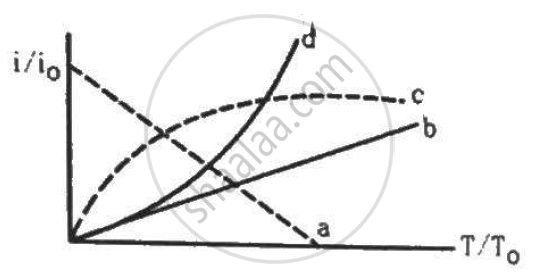Advertisements
Advertisements
Question
The work function of a metal is 2.31 eV. Photoelectric emission occurs when the light of frequency 6.4 × 1014 Hz is incident on the metal surface. Calculate
- the energy of the incident radiation,
- the maximum kinetic energy of the emitted electron and
- the stopping potential of the surface.
Solution
(i) Frequency of incident radiation = ν = 6.4 × 1014 Hz
Energy of incident radiation = E = hν = 6.6 × 10−34 × 6.4 × 1014 = 42.24 × 10−20 J
(ii) KEmax = hν − Φ0
∴ KEmax = 42.24 × 10−20 − 2.31 × 1.6 × 10−19 = 5.28 × 10−20 J
(iii) If stopping potential = VS, then
eVS = KEmax
∴ VS = `"KE"_"max"/"e"`
= `(5.28 xx 10^-20)/(1.6 xx 10^-19)`
= 3.3 × 10−1
= 0.33 V
APPEARS IN
RELATED QUESTIONS
Find the (a) maximum frequency, and (b) minimum wavelength of X-rays produced by 30 kV electrons.
Quarks inside protons and neutrons are thought to carry fractional charges [(+2/3)e; (–1/3)e]. Why do they not show up in Millikan’s oil-drop experiment?
Would you prefer a material with a high work-function or a low work-function to be used as a cathode in a diode?
Why does thermionic emission not take place in non-conductors?
The cathode of a diode valve is replaced by another cathode of double the surface area. Keeping the voltage and temperature conditions the same, will the place current decrease, increase or remain the same?
Let i0 be the thermionic current from a metal surface when the absolute temperature of the surface is T0. The temperature is slowly increased and the thermionic current is measured as a function of temperature. Which of the following plots may represent the variation in (i/i0) against (T/T0)?

The anode of a thermionic diode is connected to the negative terminal of a battery and the cathode to its positive terminal.
The constant A in the Richardson−Dushman equation for tungsten is 60 × 104 A m−2K−2. The work function of tungsten is 4.5 eV. A tungsten cathode with a surface area 2.0 × 10−5 m2 is heated by a 24 W electric heater. In steady state, the heat radiated by the heater and the cathode equals the energy input by the heater and the temperature becomes constant. Assuming that the cathode radiates like a blackbody, calculate the saturation current due to thermions. Take Stefan's Constant = 6 × 10−8 W m−2 K−1. Assume that the thermions take only a small fraction of the heat supplied.
Why do metals have a large number of free electrons?
Give an example each of a metal from which photoelectric emission takes place when irradiated by
- UV light
- visible light.
